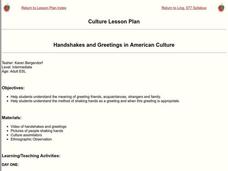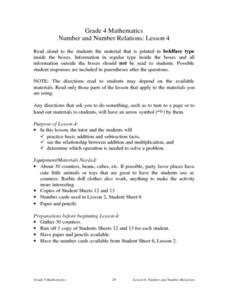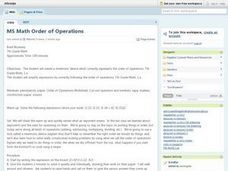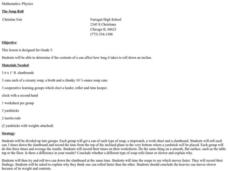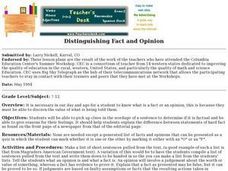Curated OER
Handshakes and Greetings in American Culture
Students explore the meaning of greeting friends, acquaintances, strangers and family and learn when shaking hands is appropriate.
Curated OER
Ground Beef Experiment
Students identify what ground beef is and the difference in fat, flavor and moistness between the three types - regular, lean, and extra lean. Then, they conduct an experiment to compare the effect of pan frying
between three different...
Curated OER
Dribbling Math Challenge
Students practice foot dribbling and hand dribbling with control. In addition it helps to reinforce math concepts.
Curated OER
Short Story Writing
Students develop skills needed to write short stories. They pick out an object in the room and describe it without saying what it is. They describe their hand and the lines on their hand without using words "Line, finger,skin or vein"
Curated OER
Working Watermelon
You're going to wish you had a watermelon for this lesson! Class members read about watermelons and make a salad in class to sample. They also perform estimates, measurements and calculations on a watermelon. They predict what percentage...
Curated OER
Grocery Races
Fifth graders apply their knowledge of math in a grocery shopping trip. In this math lesson, 5th graders use addition, subtraction, multiplication and division to help them with their shopping. The teacher sets up a mock supermarket in...
Curated OER
Morning Work
First graders complete their morning work. In this math and editing lesson, 1st graders complete addition and subtraction problems, edit sentences and share their answers. Students can also create math problems of their own.
Curated OER
Number and Number Relations: Lesson 4
Fourth graders investigate the use of addition and subtraction facts in different situations. They examine the relationship between addition and multiplication and determine which operation is needed to solve various problematic situations.
Curated OER
Absolute and Relative Location
Second graders understand the difference between relative and absolute location using the grid map as an example of an absolute location. They observe a class map showing longitude and latitude lines and learn that they provide exact...
Curated OER
Made You Mad
Students explore the phoneme for the vowel-consonant-silent e grapheme. They recognize the silent "e" at the end of words and practice speaking them. Students say words, spell them, and say tongue twisters with the vowel differences. ...
Curated OER
MS Math Order of Operations
Seventh graders create a mnemonic device which correctly represents the order of operations. They simplify expressions by correctly following the order of operations. Students use PEMDAS-parentheses, exponents, multiplication,...
Curated OER
The Soup Roll
Fifth graders roll different sized cans down an inclined ramp in order to determine if the contents of a can affect the speed at which is rolls. For this physics lesson, 5th graders work in small groups to send each can down the ramp...
Curated OER
How Do Words Feel?
Students discuss the difference between harsh words and soft words, and how words feel. They feel various mystery materials such as sandpaper, or cotton, and decide if the materials would describe a word that is harsh or soft.
Curated OER
Bare/Bear
In this bare and bear worksheet, students read about the difference between the words bare and bear. They complete sentences where they choose the correct word. Students complete 9 sentences with either bare or bear.
Curated OER
What Weather When and Where?
Students learn the difference between hard news and feature writing. They choose one of these news styles to write a compelling weather-related article based on interviews with local sources.
Curated OER
A Survey of Ancient Religions
Students examine ancient religions of Confucianism and Buddhism. Pupils prepare a K-W-L chart, Venn Diagram and participate in think-pair-share activities. Classmates compare and contrast Confucianism and Buddhism. They explore the...
Curated OER
Interior Design Proportion and Scale
Students explore the principle of design proportion and scale using discussion, projects, state core standards, etc. They recognize the difference between scale and proportion for practical application in their own lives and describe...
Curated OER
Buh Bee and Duh Dee
Learners differentiate between /b/ and /d/ in both written and spoken words. They listen to the /buh/ and /duh/ sounds in words, a tongue twister, and in Audrey Wood's, Silly Sally. They recite the tongue twister before writing /b/ and...
Curated OER
Invertebrates
Students identify the characteristics common to all animals. In groups, they compare the characteristics between the animals and how they are divided. To end the lesson, they compare the eight phyla of invertebrates and review the...
Curated OER
Normal Distribution
Students complete problems on normal distribution equations. In this algebra lesson plan, students complete 11 problems out of their text book.
Curated OER
Learning Respect and Manners
Fourth graders explain the difference between respectful and disrespectful behaviors. They review and explain the six pillars of character, by writing in their journals reasonable ways they can demonstrate the six pillars in their lives.
Curated OER
Abstract Flowers Inspired By Georgia O'Keeffe
Students create a drawing of a flower using Georgia O'Keeffe as their inspiration, then develop skills in drawing and composition. They explain the difference between realistic and abstract.
Curated OER
Distinguishing Fact and Opinion
Students pick up clues in the wordage of a sentence to determine if it is factual and give reasons for their feelings. They explain difference between statements of hard fact as found on the front page of a newspaper from that of an...
Curated OER
Friction and Gravity
Seventh graders identify the factors that determine the strength of the friction forces when two objects push against each other. Describing the difference between weight and mass, they participate in experiments. They state the law of...


